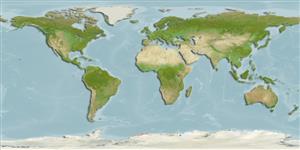Environment: milieu / climate zone / depth range / distribution range
Ecology
Marine; bathydemersal; depth range 247 - 460 m. Deep-water; 70°S - 74°S
Southern Ocean: Weddell Sea and East Antarctica (Prydz Bay).
Size / Weight / Age
Maturity: Lm ? range ? - ? cm
Max length : 26.0 cm TL male/unsexed; (Ref. 5181)
The only species of the genus with conspicuous ventral spots. Adults maybe nesters due to low absolute fecundity (Ref. 52020).
Low absolute fecundity of this species may indicate nesting behavior.
Eakin, R.R., 1990. Artedidraconidae. p. 332-356. In O. Gon and P.C. Heemstra (eds.) Fishes of the Southern Ocean. J.L.B. Smith Institute of Ichthyology, Grahamstown, South Africa. (Ref. 5181)
IUCN Red List Status (Ref. 130435)
Threat to humans
Harmless
Human uses
Fisheries: of no interest
Tools
Warning: mysqli::__construct(): (HY000/1040): Too many connections in /var/www/html/includes/speciessummary.lib.php on line 2104
Can't connect to MySQL database fbquizv2. Errorcode: Too many connections
